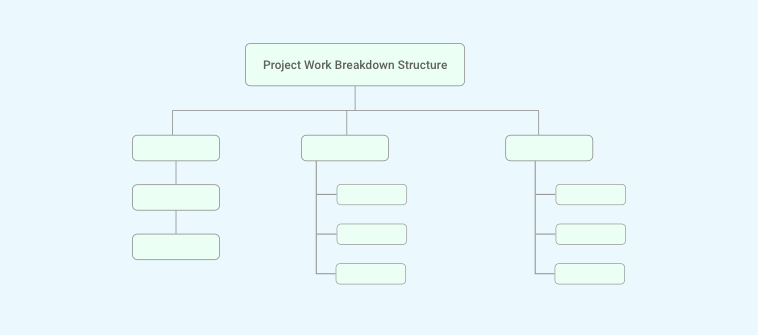
WBS (work breakdown structure) is a method to make complex projects more manageable. It means breaking down a project into tasks and subtasks so that there is no room for confusion in the future. This is usually practiced by project managers to simplify the process of execution of tasks during the scope of the project.
Every project, no matter whether it is small or big, plays a pivotal role in deciding business longevity. It is because you gain clients’ trust and loyalty with every project’s success, and this keeps your business in a pole position.
Of course, the road to success is not easy, but what is a success without challenges? Plus, you must be ready for anything, as that is the true characteristic of a business owner. To keep the success ratio on the higher side, businesses use a reliable project management tool.
Having a prodigious project management tool in place is prominent, as the devil-may-care attitude can bring down the curtain on your business.
According to the reports surfaced on the internet, 80% of businesses waste at least half of their time in reworking on projects.
Generally, complex projects cause problems, or should I say, multi-step projects give a vexing experience until their completion. To take care of challenging projects smoothly, a classic project management methodology is used, i.e., work breakdown structure (WBS).
Plus, if the concerned teams know exactly what they are supposed to achieve by the end of week or month, there is a likelihood they will complete all the assigned tasks on/before time. As a consequence, the chances of project success will increase.
Let’s dig deeper with Work breakdown structure example.
Imagine a scenario, where you are the owner of an animation company and want to create a computer game as per your clients’ instructions. However, you have a tight time window so, what would you do to complete such crucial task efficiently?
The ideal business practice says to divide and assign tasks related to story writing, drawing, and development, to different teams so that things can be done aptly and quickly. That’s exactly how the work breakdown structure in project management works.
We have told you the definition of WBS and given you an easy-to-understand work breakdown structure example.
Why Is Work Breakdown Structure in Project Management Essential to Use?
There are three major reasons to use a work breakdown structure for project management:
- Setting project budget properly
- Identifying potential risks
- Executing projects delightfully
1. Setting Project Budget Properly
It is understandable that using WBS for software projects, especially for small ones, should not be mandatory. But at the same time, there is no harm in employing this project management methodology as it will only help to improve the success rate.
The fate of client-centric companies totally depends on one factor: ‘How well you set a budget for each project.’ It is extremely important because if you ask for more money than your client’s expectations, you will definitely not get the project. While if you agree to the lesser amount, you are likely to bear loss at the end.
So, yes, you can say that using a work breakdown structure in project planning is the key to set an appropriate budget.
2. Identifying Potential Risks
Let’s get this straight, companies hand over projects to third-party firms so that they don’t have to deal with any sort of hassle. Risks are part of projects, unfortunately. And you have to get over them during the initial stages of projects so that the further process is smooth. This factor shouldn’t be taken lightly because if you miss out on spotting risks, then you are likely to encounter annoying problems while handling projects. In short, every unidentified risk could become a reason for project failure. This is where the significance of WBS in project management soars because when you divide your project into small segments, the task of identifying potential risks gets easier. It’s no brainer that you can handle projects seamlessly once ambiguities are revealed.
3. Executing Projects Perfectly
Another reason why WBS in project management is crucial to use is, it helps to complete projects on time. This is essential to keep clients’ trust and loyalty for ages, because if you take more than enough time to complete projects, there is a high possibility that clients hesitate to trust you next time. Such low confidence in your brand is not good at all. Therefore, always give your best to exceed clients’ expectations.
Good project planning helps you win half the battle, and for the rest, your way of project execution should be perfect. However, executing projects like a pro isn’t an easy job because some unforeseen factors can come out to annoy you.
This is where using a work breakdown structure seems like a wise move, because when you divide and assign tasks to your project executives, you can hope for perfect execution.
With the help of WBS, you can easily monitor how and when each task is being executed. Plus, you can analyze how much each task execution has cost you. All of this helps you keep things in control. Now, you can understand why organizations should consider WBS for software projects every time. Using a great Project Management tool can help in smooth execution of the projects.
When you have a project management tool like ProProfs Project in place, you enjoy streamlined operations. Some of the amazing features this tool offers are:
- Smooth time tracking
- Comprehensive reports
- Flawless billing
- Painless team collaboration
What are the Different Types of Project Work Breakdown Structure?
There are three different types of project work breakdown structure, which you must keep in mind to secure project success.
-
Phase-based Structures
The success rate of every project depends on how well you handle tasks in each phase of it. Errors in phase 1 can hamper the progress of the second one. At last, the whole lifecycle of the project gets disturbed.
With phase-based structures, you define project activities clearly to ensure simple and smooth execution.
-
Deliverable-based Structures
Of course, your business’s credibility relies on the number of deliverables. In case you fail to meet promised deliverables, clients are unlikely to trust you next time. This can put the brakes on your business growth.
By means of deliverable-based structures, you can determine project activities according to the deliverables you agreed on.
-
Responsibility-based Structure
To end up on the successful note, it is imperative to assign responsibilities to project executives properly. This has two-fold advantages: ‘You will have a clear idea on who is working on which task’ and ‘Your teams will know exactly what they need to achieve in the stipulated time, thereby, chances of their success will increase automatically.’
Through responsibility-based structure, you describe project activities as per responsibilities that each unit has to take care of.
What are Project Work Breakdown Structure Guidelines?
If this question has already come to your mind, it means you have absorbed the aforementioned information very well and understood the importance of work breakdown structure in project management.
Top project work breakdown structure guidelines are:
- The final deliverable of the project should be on the top level.
- Make sure all sub-deliverables comprise work packages so that each department or unit knows exactly what needs to be delivered.
- Each work package should have proper information with regards to tasks, time duration, and involved costs. It will help your project teams understand the value of each work package, and hence better work will be done.
- Ensure there is no dependency among work packages you have created, as this will reduce the odds of project failure significantly.
- See to it that all work packages are unique so that there will be no chaotic situation in the later stages.
Major Benefits of Work Breakdown Structure (WBS) in Project Management?
In the business world, employing result-oriented tactics is considered as the key to success. Therefore, you must know the benefits before using the work breakdown structure in project plan. We have round-up the benefits you gain by using WBS. Here you go:
- It facilitates team communication and coordination.
- It dwindles the chances of unnecessary changes.
- It helps in estimating the workforce, cost, and time required for project success.
- It lends a hand by shedding light on potential risks in the initial stage of projects, which further prevents financial loss.
- It smoothens the whole lifecycle of projects.
- It reduces the delay factor to a large extent.
- It makes the job of assigning responsibilities easier.
- It provides better control over each crucial task.
- It streamlines the way of project planning so that the hassle of repeat work doesn’t take place in the later stages.
- It works as a brainstorming tool for stakeholders.
Final few words:
There is no denying that the fate of every company depends on the number of successful projects. Honestly, it doesn’t matter which project management methodology you are using as long as it benefits you and your business.
With the help of this blog, we have talked about what work breakdown structure is and how it helps with respect to project management. To make sure you understand the role of WBS in project management, we have provided a vivid example, guidelines, and the list of benefits.
In case you have some questions with regards to the project work breakdown structure, tell us in the comments section. Until then, it’s goodbye.
Frequently Asked Questions
Q. How do you create a work breakdown structure?
Creating a work breakdown structure is easy as you have to keep these factors in mind:
- Divide your project into small segments.
- Assign each segment to project executives after assessing their skill set.
- Make sure no work package takes over 80 hours to complete.
- Ensure each work package is unique and independent to other ones.
Q. What are the two different ways of creating a WBS?
There are two ways of creating a WBS for project management:
- Pictorial method
- Outline method
These methods have their own importance, which means you cannot rule out any of them. Although the pictorial method gets more preference as it is easier to understand.
Q. What is WBS estimation technique?
WBS estimation technique is self-explanatory. Work breakdown structure is used for estimating three crucial factors:
- The number of project executives required to complete projects on time.
- The time that each work package would possibly take.
- The cost to complete each task perfectly.
Q. How many levels should a WBS have?
Ideally, the work breakdown structure should have 3 levels. But it is not mandatory because the number of levels also depends on the size of projects.
For instance, if you have a complex project to complete, maybe you have to create 4 to 5 levels in the work breakdown structure for better understanding or vice versa.
Do you want a free Project Management Software?
We have the #1 Online Project Management Software for effective project management.






